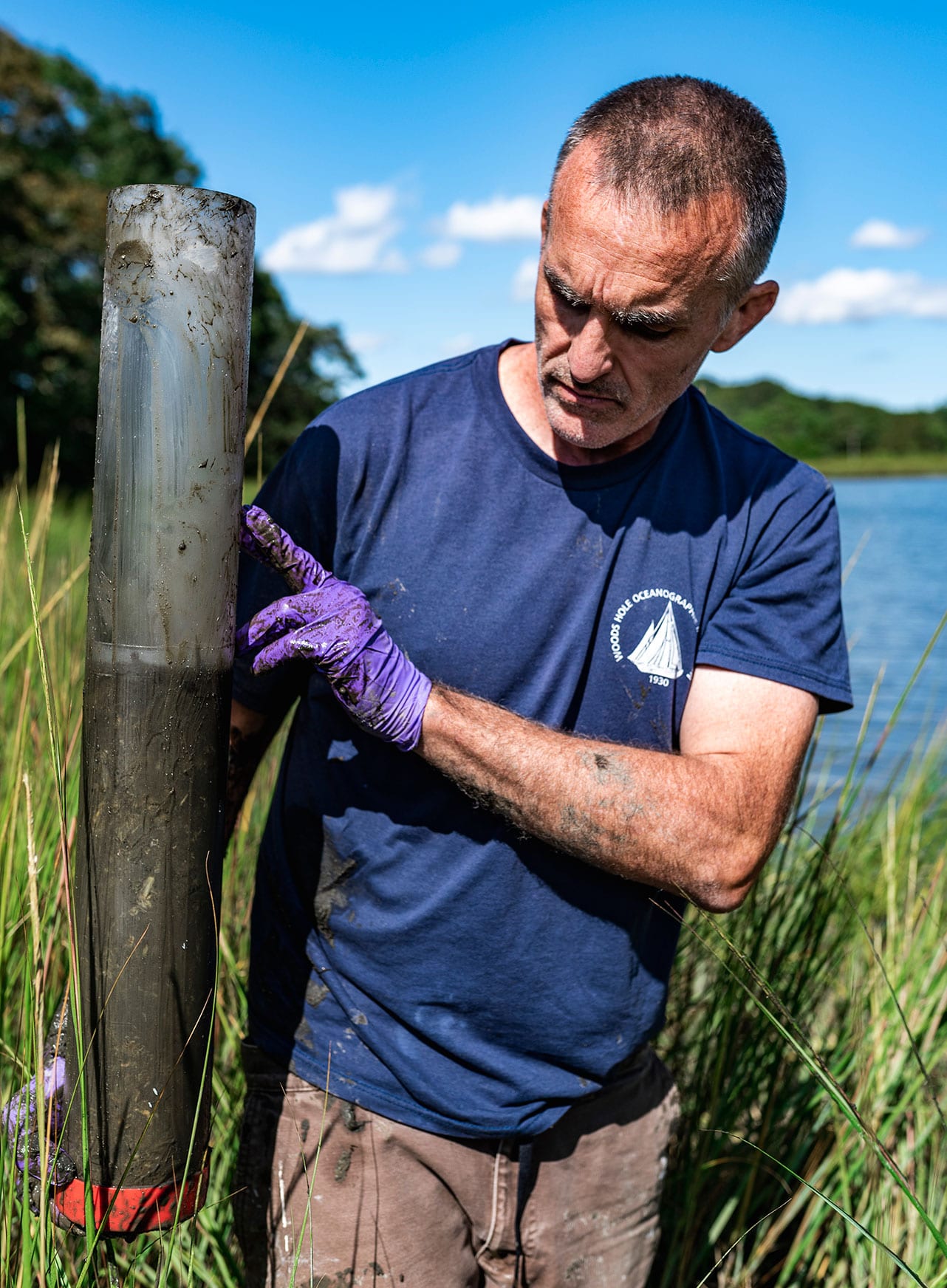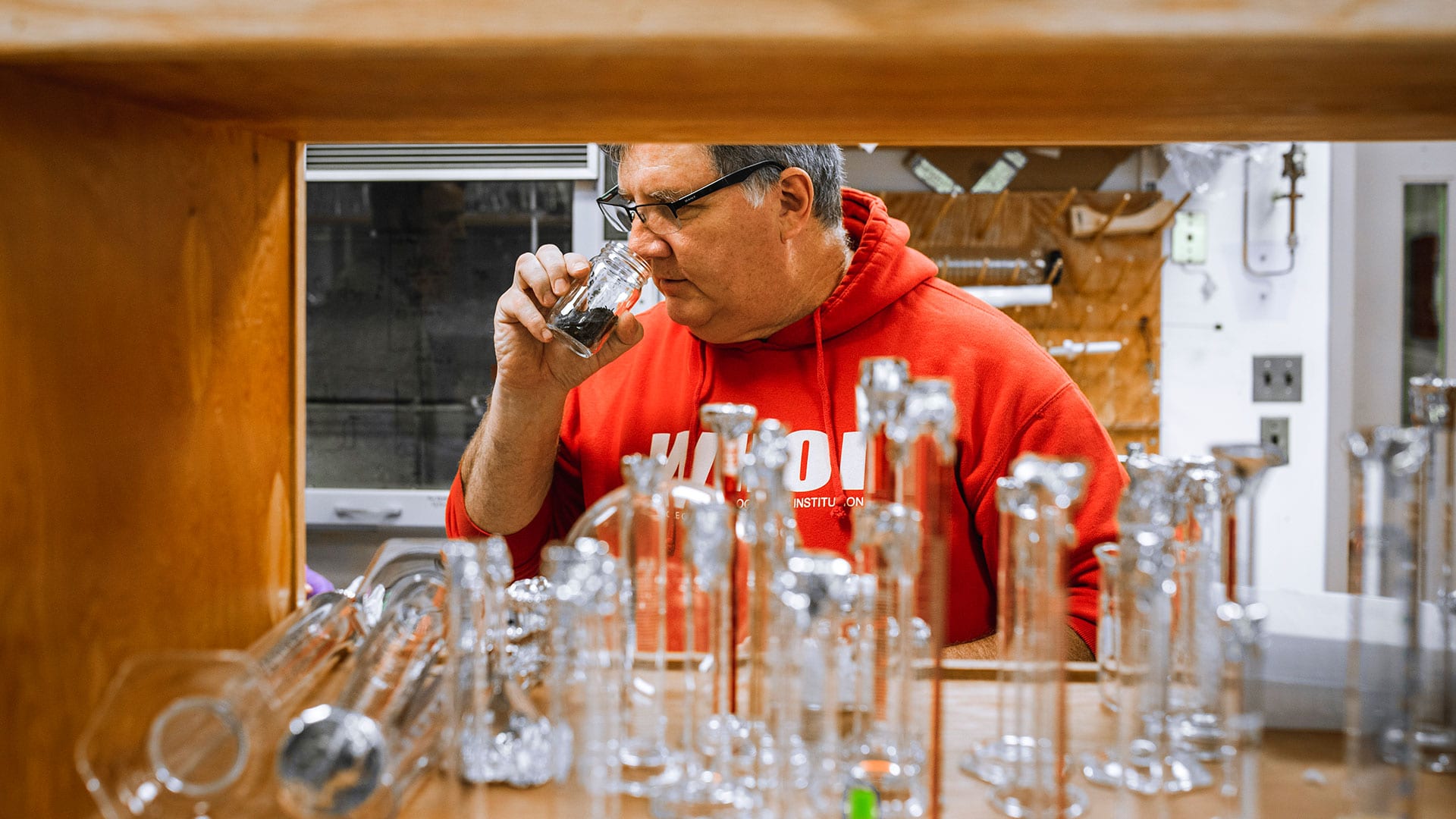Fifty years later, the West Falmouth oil spill yields lasting contributions to remediation efforts
By Daniel Hentz | September 20, 2019

Fifty years after 175,000 gallons of oil spilled from a barge that ran aground along West Falmouth Harbor, the contaminant has all but disappeared, save a small marsh inlet that continues to serve as a living laboratory for scientists at Woods Hole Oceanographic Institution (WHOI).
On Monday, WHOI marine geochemist Christopher Reddy trudged through a marsh in West Falmouth’s Wild Harbor on Cape Cod, Mass. and extracted a 1-foot-long core from a sampling area his predecessors designated as “M1.” It’s here that the dregs of more than 175,000 gallons of spilled home heating oil from the barge Florida are still detectable three inches below the surface.
Today, these pungent remains remind Reddy of the origins of oil spill science, as pioneered by a team of WHOI chemists and marine biologists who began studying the spill when it first wound up on their doorstep in 1969 – something Reddy believes ought to be celebrated.
“If this spill had been thirty miles in either direction it would have been left alone. It was really [a] scientific curiosity that this was in our backyard,” said Reddy.
Back then, the extent of the spill’s damage had been underestimated by the president of East Coast services, Russell Delano, who projected the oil would disappear within six weeks after the incident. WHOI’s scientists were skeptical.
“That’s a fantastic hypothesis for scientists to test,” said Reddy.
It was through the research of WHOI geochemist Max Blumer and the then-burgeoning practice of gas chromatography, that researchers could track the presence of the oil by its unique signature. His process ultimately confirmed that the slick did not dissipate, but instead seeped into the coastline and would remain there for years.
WHOI marine biologists George Hampson and Howard Sanders, and shellfish expert George Souza, then corroborated Blumer’s data through a series of surveys that showed the oil had indeed settled on the ocean floor, smothering more than 90 percent of the local marine invertebrates.

“I think the most important thing is the fact that this was multidisciplinary work between people studying animals at the benthos (seafloor), people studying marsh ecology, and chemists like Max Blumer,” said Dean Emeritus John Farrington, then a post-doc student working in Blumer’s chemistry lab at the time of the spill.
Together, their work catalyzed a whole field of study, which today informs oil response and mitigation efforts for major spills like Deepwater Horizon in 2010.
Since 1969, oil from the Florida has been emulsified by the ocean through natural remediation processes such as tidal action, oxidizing sunlight, and hungry microbes, which together work to break up the hydrocarbons that comprise the oil.
What remains in the secluded cove of Wild Harbor could yield clues about oil degradation over long periods of time in areas less prone to intense tidal action. Reddy, who studied the area extensively from 1999 to 2008, wants to know why nature hasn’t expunged the oil from this tiny area.
“You have to ask yourself, ‘Where does the dust collect in my house?’ The answer is in the sleepy, [undisturbed] places,” he said. “And that’s where the oil is tucked away.”
When the oil entered Wild Harbor, it destroyed many of the grasses that fortify the coastline – a kind of natural rebar, according to Reddy. Some of the affected marshes have regrown since 1969, but a number of small pockets outside of Wild Harbor have not rebounded and are now prone to erosion.
Keeping marsh lands intact may help soften the blow of rising seas, which on the Cape could elevate by up to two feet in 2100, according to a 2016 report published by USGS on sea level rise.
Today, Reddy and Farrington see the now-thriving harbor as nature’s victory over the 1969 disaster. It’s because of this work that marsh lands are now blocked off at the first sign of a spill, according to Reddy.
“I wanted to celebrate the fact that nature actually won in the long term,” offered Reddy, noting the fiddler crabs flitting about the ground. “It’s not necessarily a special birthday. It’s just an opportunity to [applaud] the fact that really good science was done here.”


